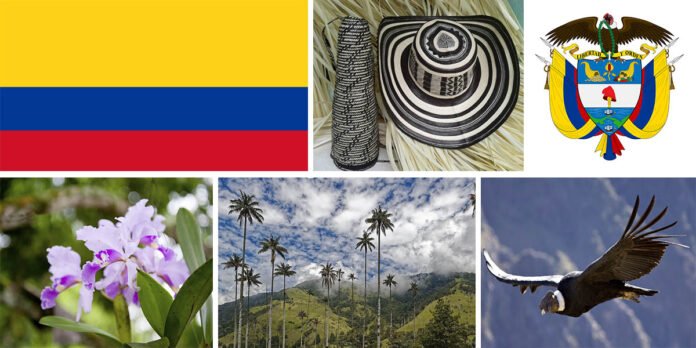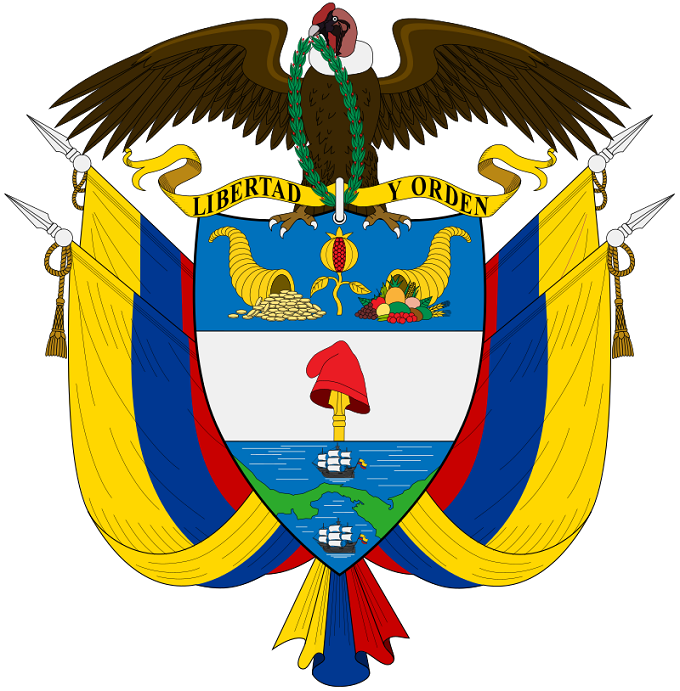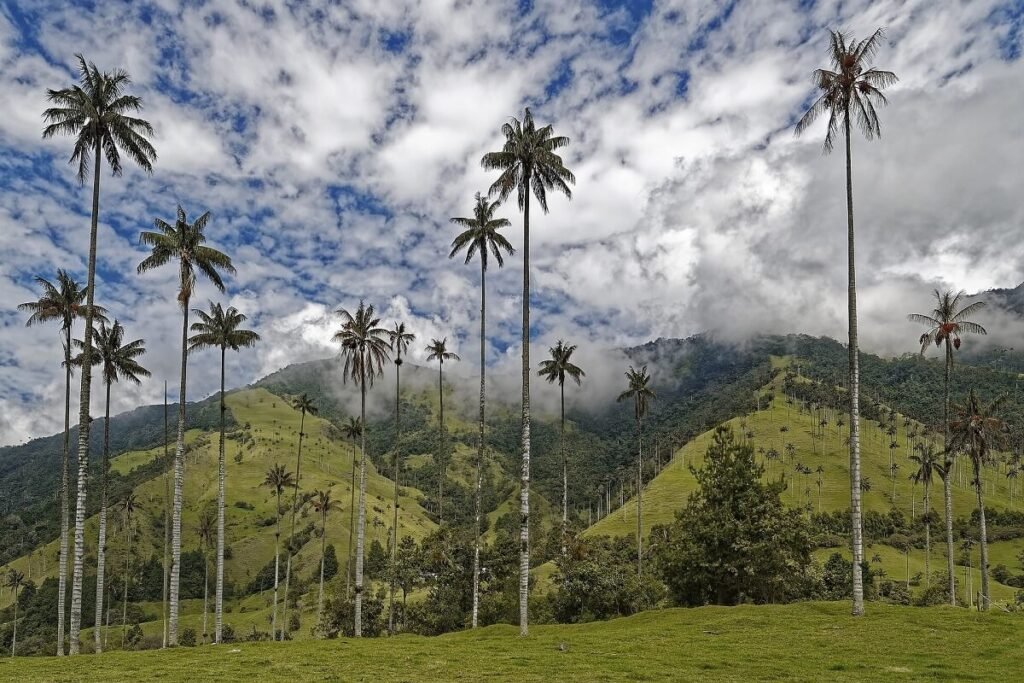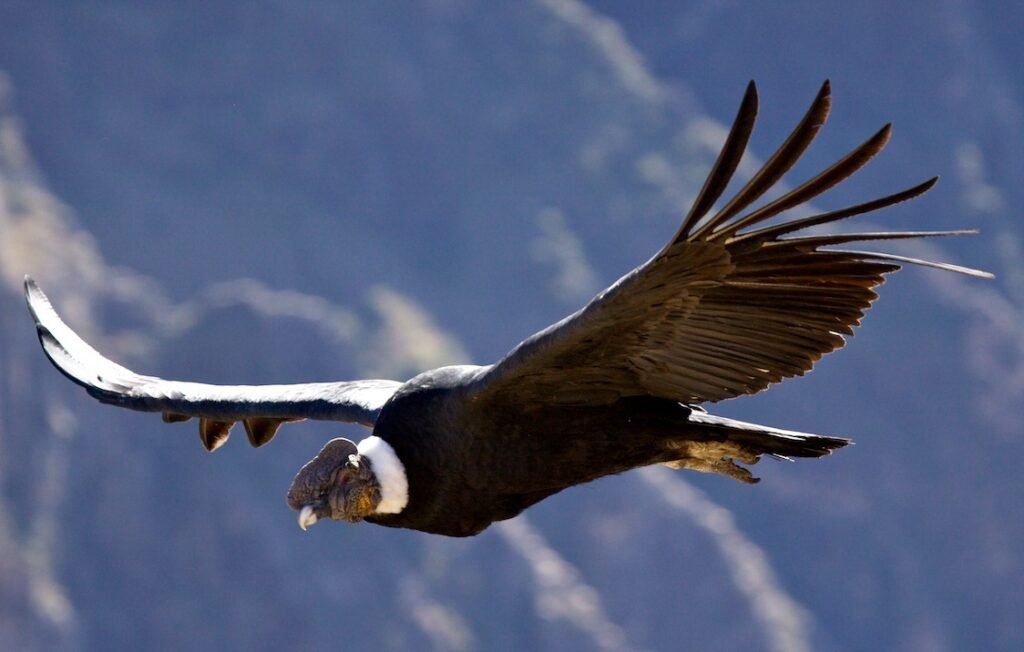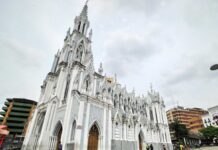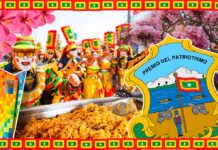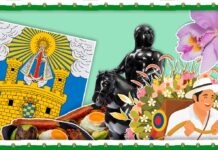Los Símbolos Patrios y culturales de Colombia son aquellos símbolos y emblemas que representan al país en eventos oficiales, estos elementos se destacan por su importancia social, ambiental y cultural.
Bandera de Colombia:
En el año 1807, Francisco Miranda, uno de los precursores de la independencia nacional, acuñó los colores amarillo, azul y rojo para representar al entonces territorio en camino de la independencia. Cuatro años más tarde la bandera fue adoptada como insignia de la Gran Colombia y en 1813 ratificada por el libertador Simón Bolívar. En 1861 se dispuso que las franjas serían horizontales y el color amarillo ocuparía la mitad superior de la bandera. El día de la bandera se celebra el 7 de agosto.
Sobre lo que representan los colores de la bandera hay varias versiones, pero la más utilizada en Colombia es:
Amarillo: Simboliza las riquezas naturales de Colombia.
Azul: Los dos mares que bañan a Colombia.
Rojo: La sangre derramada por los próceres y soldados en el camino hacia la independencia de Colombia.
Escudo de Colombia:
El actual emblema y sus elementos constituyentes tienen sus orígenes en el escudo aprobado por medio de la ley 3 del 9 de mayo de 1834, siendo presidente de la República de la Nueva Granada el general Francisco de Paula Santander. Los colores y la disposición de los mismos fueron adoptados y reafirmados sucesivamente por varios decretos, particularmente los dictaminados el 17 de mayo de 1924 y el 11 de enero de 1934. Finalmente el escudo es reglamentado por medio del decreto 3558 del 9 de noviembre de 1949, el cual además describe de manera puntual la reproducción de la mayoría de sus partes. El escudo vigente en la actualidad recoge tanto los elementos dictaminados en 1834 como los descritos en 1924 y 1949, con sus respectivas mejoras estéticas.
Blasón: Terciado en faja; en jefe de azur una granada de oro en el centro, a su diestra un cuerno de la abundancia de oro vertiendo monedas y su siniestra un cuerno de la abundancia vertiendo frutas y verduras; en faja central de plata un gorro frigio de gules sostenido por una lanza; en punta de azur el istmo de Panamá en verde con una embarcación en jefe y otra en la base.
Timbre: Cóndor de los Andes de frente con alas extendidas, mirando a la derecha, y corona de laurel en el pico; cinta de oro en la base de sus patas con la leyenda Libertad y Orden
Tenante: Cuatro banderas de Colombia rodeando el blasón.
Lema: Libertad y Orden.
Himno de Colombia Completo:
La letra del himno está compuesta por un coro y once estrofas, fue escrita por el presidente Rafael Núñez originalmente como una oda para celebrar la independencia de Cartagena. La música fue compuesta por el italiano Oreste Síndici a instancias del actor José Domingo Torres, durante la presidencia de Rafael Núñez y presentada al público por primera vez el 11 de noviembre de 1887. La canción adquirió gran popularidad y fue rápidamente adoptada, aunque de manera espontánea, como el himno nacional de Colombia.
(Lea También: Símbolos patrios y culturales de Cartagena de indias)
Se oficializó a través de la ley 33 del 18 de octubre de 1920. El músico José Rozo Contreras revisó las partituras y preparó las transcripciones para la banda sinfónica, la cual fue adoptada como versión oficial mediante el decreto 1963 del 4 de julio de 1946.
Flor Nacional de Colombia
La orquídea de la variedad Cattleya Trianae es la flor nacional de Colombia, la cual es una especie única en Colombia, esta flor fue denominada Cattleya Trianae en honor del naturalista Colombiano José Jerónimo Triana, también se le conoce como flor de mayo o lirio de mayo.
Fue escogida como flor Nacional según un concepto emitido por la Academia Colombiana de Historia en 1936, aun cuando no ha sido consagrada oficialmente por ley; Es de conocimiento mundial que las orquídeas colombianas son de las mas hermosas del mundo y la Cattleya Trianae destaca como una de las variedades mas bellas, por su estructura y colores.
Árbol Nacional de Colombia
La Palma de Cera del Quindío (Ceroxylon quindiuense) es el árbol nacional de Colombia, es una palma nativa de los bosques montañosos húmedos andinos del Parque Nacional Natural Los Nevados, es una especie única en Colombia, es un árbol capaz de vivir durante mas de 100 años y puede llegar a medir hasta 70 metros.
El Congreso de la República declaro a la palma de cera del Quindío como árbol nacional mediante la Ley 61 de 1985, sancionada el 16 de septiembre por el presidente Belisario Betancur.
El Sombrero Vueltiao (Símbolo cultural de Colombia)
El sombrero vueltiao es una prenda de vestir típica de las sabanas del Caribe colombiano de origen Zenú. El Congreso de Colombia lo elevó a la categoría de Símbolo Cultural de la Nación mediante la Ley 908 del 8 de septiembre de 2004.
Ave Nacional de Colombia
El cóndor es considera el ave nacional de Colombia, conocido científicamente como Vultus Gryphus, fue escogido en 1834 como emblema de libertad y soberanía. Es el ave voladora de mayor tamaño en el mundo, la longitud de las alas abiertas alcanza tres metros, característica que explica su alto vuelo.
Se encuentra en la cordillera de los Andes en Sudamérica, especialmente en Colombia, Perú y Chile. Fue escogido en 1834 como emblema de libertad y soberanía para el escudo nacional.


